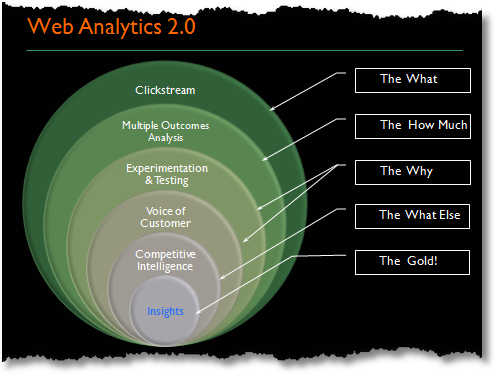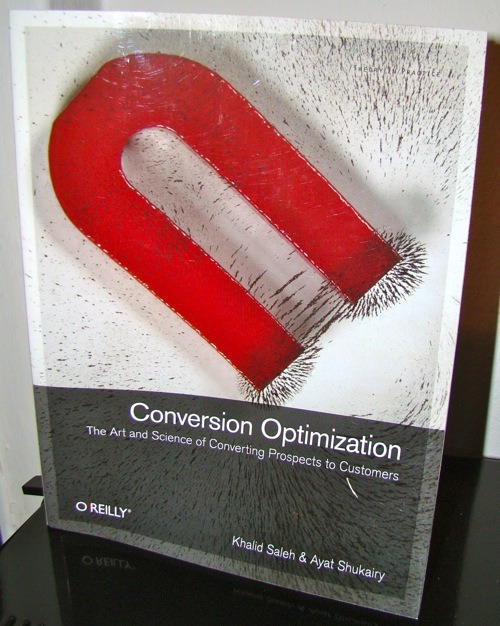Data Quality Sucks, Let’s Just Get Over It
- Data quality in the web is not great
- Six step plan:
- Don’t dive deep into the data to find discrepancy between data
- Assume a level of comfort with the data
- Start making decision that you are comfortable with
- Over time start understanding small areas of data
- Get more comfortable over time with your data
- Absolute numbers rarely matter, segmented trends do
Tips for Web Analytics Success for Small Businesses
- Get top key phrases from search
- Get top referring URLs
- Which content is popular on your site?
- Percentage of Visitors on the homepage
- Check segmented click densities
- Learn about your site’s bounce rates
Measuring Success for a Support Website: A Point of View
- Moment of Truth: hold or lose customers — web: often support problems
- Don’t measure unique or total visitors
- Identify top methods to customers find information
- Click Density Analysis for the Top FAQ pages
- What percent of site visitors call the support phone number?
- Measure: Problem resolution, timeliness, likelihood to recommend
- Check if the top solutions are corresponding to the top real problems (call center, user forums, blogs, etc.)
Seven Steps to Creating a Data Driven Decision Making Culture
- Go for the bottom-line (outcomes): What motives the people around you?
- Reporting is not Analysis
- Depersonalize decision making
- Proactive insights rather than reactive: Deliver insights before someone asks
- Empower your analysts: They are not reporting monkeys. Give them strategic objectives
- Solve for the Trinity: What, Why, How much?
- Create a understandable, repeatable framework for making decisions
- Business/Strategy should own web analytics
Five “Ecosystem” Challenges for Web Analytics Practitioners
- Lack of relevant talent / skills: No real format training; too much experience requested (5+ years) although the field is moving fast
- Entrenched mindsets: Decision makers still thinking in the old way
- The web is no longer a monologue
- It’s not about you, it’s about your customers: Less clickstream, more experimentation, usability, integration of multiple sources
- Web analytics is the first step
Web Analysis: In-house or Out-sourced or Something Else?
- In the long run: in-house team
- strategic implementation of WA can’t exist in a silo
- Qualitative analysis is also needed
- Tribal knowledge helps the decision making
- But, it depends on the stage:
- Stage 1 – No WA -> Implement and show promise from data
- Stage 2 – Too much data -> Hire WA, customize dashboards, tag everything
- Stage 3 – WA rocks; Asking the why -> Start testing, collect qualitative data, expand your team
- Stage 4 – Trinity implemented -> new data, more people, a self-sustaining process
Five Rules for High Impact Web Analytics Dashboards
- Benchmark & Segment: Provide context
- Isolate your critical few metrics: less than 10 metrics
- Include insights
- Don’t create more than one single page
- Constantly adapt your dashboard to changes in the environment
I Got No Ecommerce. How Do I Measure Success?
- Visitor Loyalty: How often does one person visit my website?
- Recency: How long has it been since a visitor last visited your website?
- Lengths of Visit: How long does each session last?
- Depth of Visit: How many pages did they visit?
Convert Data Skeptics: Document, Educate & Pick Your Poison
- Understand how your tools actually measure
- Document your findings
- Present everybody touching the data your findings
- Report high level trends between the tools
- Pick the best tool for each metric
Is Conversion Rate Enough? It’s A Good Start, Now Do More!
- There is more stuff than just conversions
- Esp. for non-ecommerce businesses, ask:
- Have you found what you were looking for?
- Will you go to our store?
- Will your recommend our website?
History Is Overrated. (Atleast For Us, Atleast For Now.)
- Value of web analytics data decays in time
- Your visitors change too much: browsers, cookie deletion, etc.
- Your computations change too much: new computations, maybe other tagging, etc.
- Your systems change too much: Other hosts, new technology, etc.
- Your website changes too much
- Your people change too much
- => no real tie to legacy tools and data
- => keep some major benchmarks for comparison
“Engagement” Is Not A Metric, It’s An Excuse
- Engagement is unique – therefore say what you actually measure instead of saying that you measure engagement.
- What’s the purpose of the website?
- How do you measure success?
- Define your metrics
- Call them what they are
- Ideas:
- Question: Are you engaged with us?
- Question: Likelihood to recommend website
- Use primary market research
- Customer retention
- RF of customers
In Web Analytics Context Is King Baby! Go Get Your Own
- Never report data in aggregate, or by itself. Always always always test to see if you are including context!
- Compare trends over different time periods
- Compare key metrics and segments against site average
- Report multiple metrics
- Benchmark
- Tap into the tribal knowledge
The “Action Dashboard” (An Alternative To Crappy Dashboards)
- Why do dashboards suck?
- Don’t provide a interpretation
- Readers don’t trust the providers of dashboards
- Not enough company context in the interpretation
- Providers don’t have enough experience
- How to make a good one?
- Report only 3-5 most critical metrics
- Show a trend in a graphic for a metric (segmented)
- Give key trends and insights
- Recommend actions
- What are the impacts of the company
Multichannel Analytics: Tracking Offline Conversions. 7 Best Practices, Bonus Tips
- Track your online store locator, directions, etc.
- Use unique 800 numbers
- Use unique coupons / promotions
- Connect online and offline – e.g. club cards, delivery, etc.
- Ask your customers (survey)
- Conduct controlled experiments
- Do primary research
Multichannel Analytics – Tracking Online Impact Of Offline Campaigns
- Use vanity urls: Permanent redirects help you to differentiate between offline and online referals
- Use unique coupons / offer codes
- Survey, survey, survey
- Correlate traffic patterns with offline ad patterns
- Experiment
Slay The Analytics Data Quality Dragon & Win Your HiPPO’s Love!
- Change your boss
- Compare web data with their favorite source
- Put the data quality problem aside and give them actionable insights
- You get trends rather fast even without a complete WA implementation
- Start with the outcomes
- One WA is probably enough
- Realize if the data quality is good enough
- If you don’t have enough traffic, care about more traffic first
- There are inaccurate benchmarks and illegal customer behavior – don’t care too much about it
- Fail fast, i.e. test
Barriers To An Effective Web Measurement Strategy [+ Solutions!]
- Note: Tools aren’t the real problem, still lots of people talk about them
- Lack of resources (45%): Start for free and ask your right for a budget
- Lack of strategy (31%): Change your job. If your a VP maybe you can help create one
- Siloed organization (29%): Start small and offer value
- Lack of understanding (25%): Do and show
- Too much data (18%): Limit yourself on the critical few metrics.
- Lack of senior mgm buy-in (18%): see previous summaries
- Difficulty reconciling data (17%): Whatever.
- IT blockages (17%): Show lost revenue by delay
- Lack of trust in analytics (16%): previous summaries
- Finding staff (12%): Don’t be to narrow minded
- Poor technology (9%): Concerns mostly only brand new technologies / platforms
Who Owns Web Analytics? A Framework For Critical Thinking
- The biggest problem is most often the organization structure.
- How long has the company been doing WA? -> New: find accepting division to embarrass the seniors – Older: see next point
- Analytical maturity? New: find accepting people – Older: identify power centers
- Who owns the power to make changes to the site?
- Which model: Centralized? Decentralized? Something else? Agile team with satellites
- Which division / department is best for WA? Marketing if they have the power -> Ideal situation: own department
10 Fundamental Web Analytics Truths: Embrace ‘Em & Win Big
- If you have more than one clickstream tool, you are going to fail: Implementing, understanding and communicating one tool is hard enough
- Expensive tools won’t give you insights: Real problems are lack of skills, terrible orga, no structure or no courage.
- It is faster to fail and learn then wait for an “industry case study” or find relevancy in a “industry leader white paper”
- You are never smart enough not to have a Practitioner Consultant on your side (constantly help you kick it up a notch)
- Your job is to create happy customers and a healthier bottom-line
- Go to your own website
- Read your own email campaigns
- Buy something on your own website
- Return a product on your own website
- Do the same stuff on competitor’s websites
- Do usability studies
- Be a customer and ask yourself: What will create happier customers tomorrow?
- If you don’t kill 25% of your metrics each year, you are doing something wrong
- A majority of web analytics data warehousing efforts fail. Miserably: Too much irrelevant data, mostly anonymous, full of holes, BI are bad at answering WA questions and DWs are too slow
- There is no magic bullet for multi-channel analytics: see previous summary
- Experiment, or die.
- The single most effective strategy to win over “stubborn single-minded” HiPPO’s is to embarrass them.
Measuring Incrementally: Controlled Experiments to the Rescue!
- Test everything
- You may need additional personnel for conducting and analyzing the experiment
- It gives you excellent insights in different methods
- Act on your results as fast as you can



